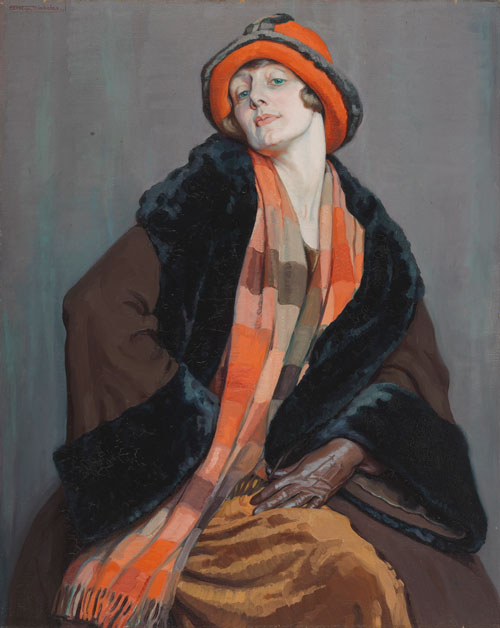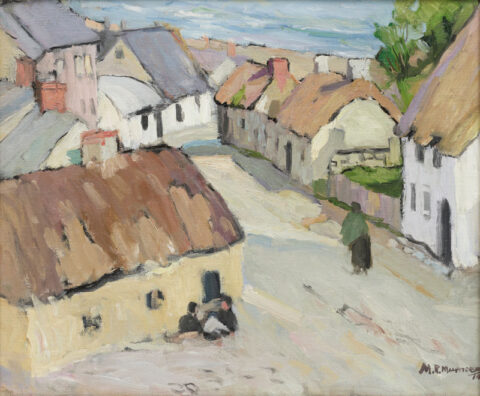Dangerously Modern: Australian Women Artists in Europe 1890-1940 is a joint exhibition curated by AGSA with the Art Gallery of New South Wales to recognise the role these artists played in the development of international modernism. It will premiere in Adelaide from May 24 until September 7 before moving to Sydney from October 10.
Drawing from the two galleries’ permanent collections, as well as national and international loans, Dangerously Modern will include more than 200 paintings, prints, sculptures and ceramics by artists such as Nora Heysen, Dorrit Black, Margaret Preston, Stella Bowen, Grace Crowley, Thea Proctor and Grace Cossington Smith.
It has been co-curated by AGSA’s Elle Freak and Tracey Lock with the Art Gallery of NSW’s Wayne Tunnicliffe, who say in a joint statement that the project reconsiders the contributions of the 50 featured artists, who were “dangerously misconceived, misunderstood and largely obscured from Australian art history”.

Hilda Rix Nicholas, Une Australienne, 1926, Île-de-France, Paris, France, oil on canvas, 103.0 x 81.0 cm. Purchased 2014, National Gallery of Australia © Bronwyn Wright
Speaking at a 2025 program launch event at AGSA yesterday, Freak (the gallery’s associate curator of Australian art), explained that the artists were part of a wave of women who travelled from Australia to Europe at the turn of the 20th century to take advantage of new opportunities available at the time in the leading art salons, schools and societies in London and Paris. From there, “they travelled widely, and adventurously, and in some cases endlessly”.
“This exhibition will dismiss tired narratives that suggest Australian artists were isolated from new ideas,” Freak says. “And to the contrary, it will demonstrate how modern art was global in its creation and reach, and how Australian women played a central role both at home and away.”
The exhibition name is inspired by an article written by Australian painter and printmaker Thea Proctor, whose art was labelled as “dangerously modern” when she returned to Sydney from London in 1921.
“Her words now serve for us as a reminder of the boundaries that these women artists were breaking, as well as the risk of their neglect over time,” says Freak.
Lock, AGSA’s curator of Australian art, says while the featured artists were informed, talented and successful, they faced the risk of “triple obscurity” – because they were women, because they were travelling artists working outside of Australia, and because “they were depicting subjects deemed insignificant to the public agenda”.
Among the key figures whose stories will be shared through the exhibition is Stella Bowen, who was born in North Adelaide in 1893 then left for London at the age of 21 and never returned after finding success in Europe, where she painted portraits of subjects including TS Eliot, Gertrude Stein and Aldous Huxley.
AGSA says Dangerously Modern – which coincides with the 50th anniversary of International Women’s Year – will include a broad range of works, “from large public statements to private portrait miniatures”, and also broaden visitors’ understanding of modern art movements.

Margaret Preston, A view of the Irish coast, 1914, oil on canvas, 56.7 x 63.5 x 5.3 cm (frame); Art Gallery of NSW. Purchased with support of the Art Gallery Society of NSW through the Elizabeth Fyffe Bequest 2023 © Margaret Rose Preston Estate / Copyright Agency
Opening in November at the Art Gallery of South Australia and continuing through until March 30 next year will be another exhibition of works by artists whose work is described as “radical” but may also have been considered dangerous by those of a conservative persuasion. Radical Textiles aims to demonstrate how textiles have marked acts of “resistance, revival, remembrance and reconciliation” over the past 150 years, with a diverse collection of items ranging from former SA premier Don Dunstan’s pink shorts, to suffragette banners, and memorial quilts created to remember lives lost during the AIDS epidemic.
Other exhibitions in 2025 will include the showcase of works by finalists in the $100,000 Ramsay Art Prize in May, and the biennial Tarnanthi Festival, which returns in spring to celebrate its 10th anniversary.
Tarnanthi will be anchored by a display at AGSA of works by Aboriginal and Torres Strait Islander artists from previous festivals, including the monumental installation Kuḻaṯa Tjuṯa which was created by artists in the Aṉangu Pitjantjatjara Yankunytjatjara (APY) Lands to represent the atomic bomb testing at Maralinga in the 1950s and ’60s .
Kuḻaṯa Tjuṯa comprises 550 kuḻaṯa (spears) suspended from the ceiling to resemble a nuclear explosion, with hand-carved piti (wooden bowls) beneath representing the loss of lives and food sources. Accompanied by a moving image component with artists talking about their experiences of being removed from country during the testing, it was originally presented at the 2017 Tarnanthi Festival and returns home after touring the United States.

Get InReview in your inbox – free each Saturday. Local arts and culture – covered.
Thanks for signing up to the InReview newsletter.
AGSA’s 2025 program will also include presentations of new work by SALA feature artist Sue Kneebone and SA-based Guildhouse Fellow Kyoko Hashimoto, along with the co-presentation Morris & Co, opening in March at Carrick Hill, which will feature objects and artworks by 19th-century designer William Morris.
Support local arts journalism
Your support will help us continue the important work of InReview in publishing free professional journalism that celebrates, interrogates and amplifies arts and culture in South Australia.
